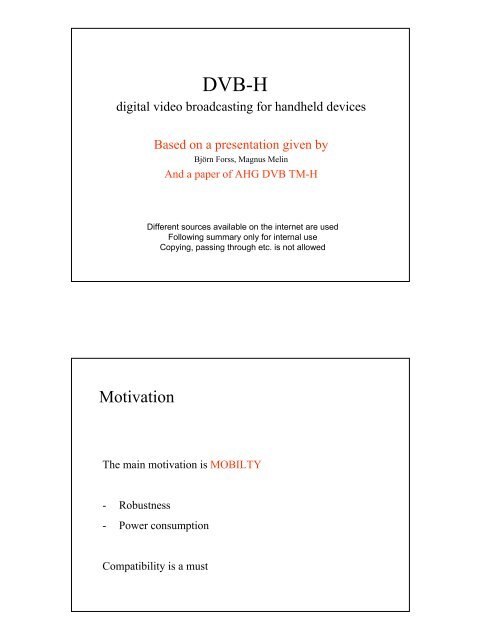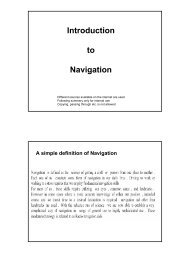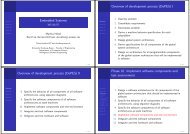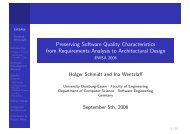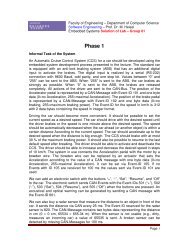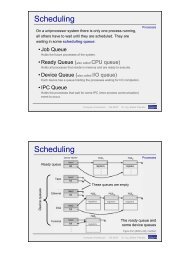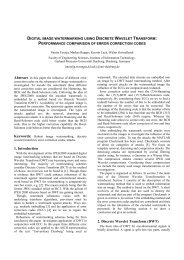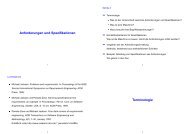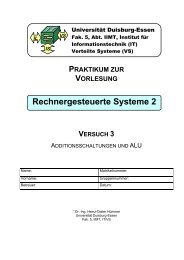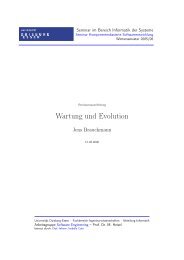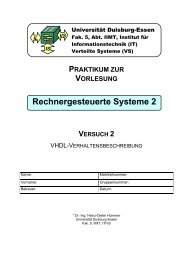Notes on DVB-H
Notes on DVB-H
Notes on DVB-H
You also want an ePaper? Increase the reach of your titles
YUMPU automatically turns print PDFs into web optimized ePapers that Google loves.
<strong>DVB</strong>-H<br />
digital video broadcasting for handheld devices<br />
Motivati<strong>on</strong><br />
Based <strong>on</strong> a presentati<strong>on</strong> given by<br />
Björn Forss, Magnus Melin<br />
And a paper of AHG <strong>DVB</strong> TM-H<br />
Different sources available <strong>on</strong> the internet are used<br />
Following summary <strong>on</strong>ly for internal use<br />
Copying, passing through etc. is not allowed<br />
The main motivati<strong>on</strong> is MOBILTY<br />
- Robustness<br />
- Power c<strong>on</strong>sumpti<strong>on</strong><br />
Compatibility is a must
Introducti<strong>on</strong><br />
• C<strong>on</strong>vergence of digital media and communicati<strong>on</strong> give users<br />
possibility to c<strong>on</strong>sume most digital c<strong>on</strong>tent also in mobile envir<strong>on</strong>ment<br />
• The emerging <strong>DVB</strong>-H standard aims to provide digital TV recepti<strong>on</strong> in<br />
mobile devices (earlier known as <strong>DVB</strong>-X)<br />
• <strong>DVB</strong>-H is being standardized by and ad hoc group of the <strong>DVB</strong><br />
organizati<strong>on</strong><br />
– Proposal submitted to ETSI in the first quarter of 2004<br />
• <strong>DVB</strong>-H combines traditi<strong>on</strong>al televisi<strong>on</strong> broadcast standards with<br />
elements specific to handheld devices; mobility, smaller screens and<br />
antennas, indoor coverage and reliance <strong>on</strong> battery power<br />
Motivati<strong>on</strong> for creating <strong>DVB</strong>-H<br />
• Why not use UMTS?<br />
– Not scalable for mass c<strong>on</strong>tent delivery<br />
– For delivery of mass media c<strong>on</strong>tent, broadcast networks should be<br />
preferred over point-to-point cellular networks<br />
• Why not use <strong>DVB</strong>-T?<br />
– Was designed for rooftop recepti<strong>on</strong><br />
– Need for an efficient power saving mechanism<br />
– Inadequate impulse noise protecti<strong>on</strong><br />
• Why not use DAB?<br />
– Designed to better fulfill power c<strong>on</strong>straints; but!<br />
– Capacity left for data transmissi<strong>on</strong> is expected to be limited<br />
(primary usage for audio)<br />
HOWEVER! DAB is technologically the best suited system!!!
<strong>DVB</strong>-T<br />
• Terrestrial Digital Televisi<strong>on</strong> Standard<br />
– Used in 36 countries world wide<br />
• One-to-many broadband wireless data<br />
transport<br />
– Video, audio, data and – importantly – IP packets<br />
– Scalable: cell size up to 100km (<strong>DVB</strong>-H cell size is smaller)<br />
– Huge capacity: 54 channels each 5-32Mbit/s<br />
• Shut down of analog TV will free up huge<br />
frequency capacity for <strong>DVB</strong>-T usage<br />
<strong>DVB</strong>-T (2)<br />
<strong>DVB</strong>-T = Digital Video Broadcasting - Terrestrial<br />
• Developed for MPEG-2 stream distributi<strong>on</strong>, but can<br />
basically carry any data<br />
– Flexible, has many modes, 4.98-31.67 Mbit/s @ C/N=25dB<br />
• COFDM multicarrier modulati<strong>on</strong> with 2k and 8k modes<br />
– One <strong>DVB</strong> channel is ~8MHz<br />
• 1705 sub carriers (spacing: 4464 Hz) - 2k mode<br />
• 6817 sub carriers (spacing: 1116 Hz) - 8k mode<br />
– Carrier modulati<strong>on</strong>: QPSK, 16 QAM or 64 QAM<br />
– Error correcti<strong>on</strong>: c<strong>on</strong>voluti<strong>on</strong>al code and Salom<strong>on</strong>-Reed<br />
• Basic mode (e. g. in Finland; for stati<strong>on</strong>ary recepti<strong>on</strong>):<br />
– 64 QAM, code rate = 2/3, guard interval 1/8<br />
– Gives 22.12 Mbits/s capacity when C/N=19.2 dB and 8 MHz channel<br />
COFDM = Coded Orthog<strong>on</strong>al Frequency Divisi<strong>on</strong> Multiplexing<br />
C/N = Carrier to Noise ratio
Mobile recepti<strong>on</strong> of <strong>DVB</strong>-T<br />
• <strong>DVB</strong>-T includes hierarchical modes where two<br />
transport streams can be sent simultaneously<br />
– Low capacity, high capacity<br />
• <strong>DVB</strong>-T can also be used for broadcast to mobile<br />
devices, but a suitable mode have to be selected<br />
– 8k 64 QAM: < 50 km/h<br />
– 2k QPSK: > 400 km/h tolerable problem with<br />
echos/coverage!!!<br />
• A separate network for <strong>DVB</strong>-H is desired<br />
– Optimizati<strong>on</strong> of speed, coverage and capacity
2k, 4k or 8k and why?<br />
• A small number of sub-carrier provides (like in 2k):<br />
– large inter-carrier spacing -> gives tolerance to the echoes affected<br />
by Doppler<br />
– short symbol durati<strong>on</strong> ->limits the maximum delay of accepted<br />
echoes<br />
• A large number of sub-carriers (like in 8k):<br />
– small inter-carrier spacing but a large symbol durati<strong>on</strong><br />
• In short, the choice of the sub-carrier number has no<br />
impact <strong>on</strong> the broadcast capacity but <strong>on</strong> the trade-of<br />
between Doppler acceptance and maximum echo delays
<strong>DVB</strong>-H compatibility pre-requisite<br />
Make it “… possible to transmit in <strong>on</strong>e<br />
<strong>DVB</strong> transport stream both <strong>DVB</strong>-H and<br />
<strong>DVB</strong>-T comp<strong>on</strong>ents in such a way that<br />
existing <strong>DVB</strong>-T receivers which cannot<br />
decode the <strong>DVB</strong>-H porti<strong>on</strong> are not<br />
disturbed by this <strong>DVB</strong>-H porti<strong>on</strong>.”<br />
<strong>DVB</strong>-H system elements<br />
• Time slicing for power saving<br />
– Time between the bursts gives the power saving (off time)<br />
Bandwidth<br />
TS bitrate<br />
1 2 3 1 2 3 1 2 3 1 2<br />
4<br />
Time<br />
Timesliced:<br />
•Service 1<br />
•Service 2<br />
•Service 3<br />
• MPE-FEC for performance<br />
• 4k mode was chosen to provide mobility in medium SFNs<br />
• Extended TPS bits for efficient signaling<br />
Not timesliced:<br />
•Service 4<br />
MPE = Multiprotocoll encapsulati<strong>on</strong><br />
FEC= Forward Error Correcti<strong>on</strong><br />
SFN= Single Frequency Network<br />
TPS= Time Phase Sync
IP Datacast (IPDC)<br />
• “IP datacasting is a service where digital c<strong>on</strong>tent<br />
formats, software applicati<strong>on</strong>s, programming<br />
interfaces and multimedia services are combined<br />
through IP (Internet Protocol) with digital<br />
broadcasting.” <br />
– All c<strong>on</strong>tent delivered as IP packets<br />
– C<strong>on</strong>nectivity layer c<strong>on</strong>vergence<br />
• <strong>DVB</strong>-H combined with IP datacasting enables<br />
distributi<strong>on</strong> of many kinds of digital c<strong>on</strong>tent<br />
– TV broadcast, music, games etc.
<strong>DVB</strong>-T and <strong>DVB</strong>-H coexistence<br />
<strong>DVB</strong>-T RF in <strong>DVB</strong>-T<br />
ETS 300 744<br />
8k, 2k, 4k, TPS<br />
Time Slicing MPE FEC<br />
IP-out<br />
<strong>DVB</strong>-H CODEC
IPDC over <strong>DVB</strong>-H business<br />
• New forms of multimedia enjoyment for<br />
c<strong>on</strong>sumers<br />
• New market opportunities for telecommunicati<strong>on</strong><br />
and broadcasting industries<br />
• High bandwidth and high transmissi<strong>on</strong> speeds but<br />
insensitive to number of recipients attractive<br />
from a business perspective<br />
IPDC = IP Datacast
Network Design Flexibility &<br />
Signaling<br />
• Different datacast network operator and cellular network operator<br />
• Digital broadcast infrastructure<br />
• More transmissi<strong>on</strong> sites than normal broadcast networks required, but<br />
less than normal cellular ph<strong>on</strong>e networks – existing masts can be<br />
reused<br />
• Cellular networks used for payment and administrative data<br />
• Cellular network and broadcast network can share same core network<br />
IP<br />
Backb<strong>on</strong>e<br />
ISP<br />
<strong>DVB</strong>-T<br />
Broadcasters<br />
<strong>DVB</strong>-H<br />
Broadcasters<br />
Mobile Operator<br />
UTMS<br />
Core<br />
Base stati<strong>on</strong><br />
Mux<br />
<strong>DVB</strong>-H<br />
transmitter<br />
Broadcast operator<br />
<strong>DVB</strong>-H features/pros<br />
• Cost efficient delivery of broadcast c<strong>on</strong>tent to a large audience<br />
• Low time to market<br />
• Low complexity<br />
• Not heavily affected of peak usage (during special events etc.)<br />
• Flexible transport stream sharing between <strong>DVB</strong>-T and <strong>DVB</strong>-H possible<br />
• Based <strong>on</strong> <strong>DVB</strong>-T with minimal changes<br />
• Fulfils most commercial requirements<br />
• Allows seamless handover<br />
• No adverse effect <strong>on</strong> <strong>DVB</strong>-T<br />
• IP allows encrypti<strong>on</strong>
<strong>DVB</strong>-H features/c<strong>on</strong>s<br />
• Only IP based services possible<br />
• Reduced power saving when total bit rate<br />
for <strong>DVB</strong>-H services is very low (no big<br />
“bursts” possible)<br />
Mobile Terminal<br />
• FE = Fr<strong>on</strong>t End, c<strong>on</strong>tains radio receiver and<br />
de-multiplexer<br />
WLAN<br />
Cellular<br />
Link<br />
FE<br />
CPU<br />
Media<br />
decoder Display
Power c<strong>on</strong>sumpti<strong>on</strong> and handover<br />
• IP encapsulati<strong>on</strong> allows sending the data in<br />
bursts to the mobile stati<strong>on</strong> and this saves<br />
energy (battery power)<br />
• Power c<strong>on</strong>sumpti<strong>on</strong> and handover<br />
– 2 Mbit buffer<br />
– Handover possible during off time (services can<br />
be used even if the terminal has moved during<br />
off time)<br />
C/N Performance<br />
• RS decoder utilizing the Time Slice buffer<br />
• Virtual time interleaver<br />
• 10% TS PER tolerated<br />
• Doppler and CN improved in mobile and<br />
portable<br />
• Impulse interference tolerance improved<br />
• Possibility to vary the level of robustness
Nokia’s 7700 with support for <strong>DVB</strong>-H<br />
“The Nokia 7700 will support the Nokia Streamer SU-6 accessory, the<br />
first mobile IP Datacast receiver designed to dem<strong>on</strong>strate the mobile<br />
ph<strong>on</strong>e televisi<strong>on</strong> experience using the <strong>DVB</strong>-H network. The Nokia<br />
Streamer can be attached to the Nokia 7700 like a battery pack, and will<br />
be used in pilot projects to showcase the future of digital broadcasting <strong>on</strong><br />
mobile devices.”


